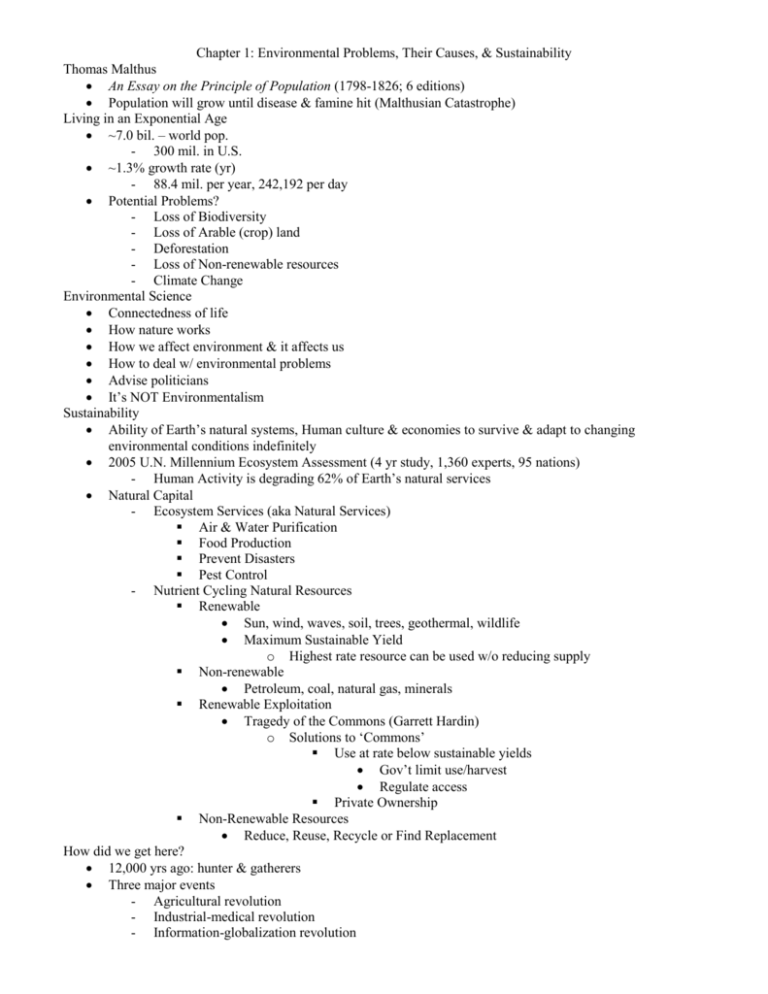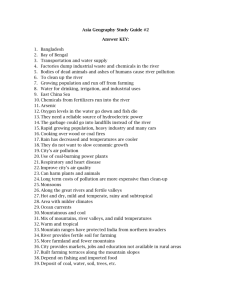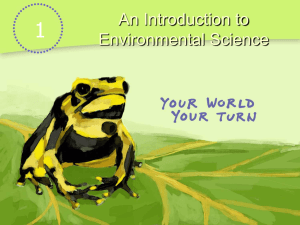Ch 1 Outline
advertisement

Chapter 1: Environmental Problems, Their Causes, & Sustainability Thomas Malthus An Essay on the Principle of Population (1798-1826; 6 editions) Population will grow until disease & famine hit (Malthusian Catastrophe) Living in an Exponential Age ~7.0 bil. – world pop. - 300 mil. in U.S. ~1.3% growth rate (yr) - 88.4 mil. per year, 242,192 per day Potential Problems? - Loss of Biodiversity - Loss of Arable (crop) land - Deforestation - Loss of Non-renewable resources - Climate Change Environmental Science Connectedness of life How nature works How we affect environment & it affects us How to deal w/ environmental problems Advise politicians It’s NOT Environmentalism Sustainability Ability of Earth’s natural systems, Human culture & economies to survive & adapt to changing environmental conditions indefinitely 2005 U.N. Millennium Ecosystem Assessment (4 yr study, 1,360 experts, 95 nations) - Human Activity is degrading 62% of Earth’s natural services Natural Capital - Ecosystem Services (aka Natural Services) Air & Water Purification Food Production Prevent Disasters Pest Control - Nutrient Cycling Natural Resources Renewable Sun, wind, waves, soil, trees, geothermal, wildlife Maximum Sustainable Yield o Highest rate resource can be used w/o reducing supply Non-renewable Petroleum, coal, natural gas, minerals Renewable Exploitation Tragedy of the Commons (Garrett Hardin) o Solutions to ‘Commons’ Use at rate below sustainable yields Gov’t limit use/harvest Regulate access Private Ownership Non-Renewable Resources Reduce, Reuse, Recycle or Find Replacement How did we get here? 12,000 yrs ago: hunter & gatherers Three major events - Agricultural revolution - Industrial-medical revolution - Information-globalization revolution Ecological Footprint - Amount of land & resources needed to produce all our goods & get rid of all our wastes Economic Power - GDP (Gross Domestic Product) Goods & services produced within a country in a given year Per capita = divided by population - Per capita GDP PPP = GDP + purchasing power parity Amount of goods a country’s citizen could buy in the U.S. Two Classes - Developed Nations U.S., Canada, Japan, Australia, New Zealand, Europe - Developing Nations China, India, all others Affluent China - Leading consumer of… Wheat, rice, meat, coal, fertilizers, steel, cement, TVs, cells, fridges - 2nd largest consumer of oil (U.S.) - Two-thirds of most polluted cities - Projections, by 2020… Largest car consumer & producer Leading economy (GDP-PPP) Effects of Affluence - Bad High levels of consumption Unnecessary waste of resources (TV, cell phones, cars) - Good Technological funding Cleaner environment – air, water, food, sanitations Prices Don’t Include Natural Capital Value - Companies receive tax breaks & subsidies; don’t pay for environmental costs - Goods & services do not include environmental costs (keeps prices low) Subsidies - Assistance paid to companies to keep costs down, promote hiring workers, keep industry profitable - Welfare, student loans, housing loans, farm subsidies (gov’t pays farmer to plant crop) - Coal Subsidies Since 1984, $1.8 billion available to coal industry for research leading to reduction in air pollution from coal combustion Another $800 million per year goes to them for further research & development - Timber Subsidies ’92-’97 – Forest Service spent $387 million in tax $$ to make roads for companies to log public owned forests - Mining Subsidies $500 mil to $1 bil in minerals a year taken from public lands, no taxes/royalties paid ($245 billion total) Mining has polluted 40% of watersheds in the West Lets companies buy public land for $5 or less per acre Pollution Point-Source Pollution – Traced to a single spot (factory, smokestack, sewage pipe) Non-point Source Pollution – Diffuse source, hard to pinpoint (runoff from farms, forests, roads) Biodegradable – can be broken down by natural means Nondegradable – can’t be broken down Pollution’s Effects - Disrupt/degrade life-support systems - Damage wildlife, human health, property - Nuisances – bad tastes, sights, smells, & noise 5 Major Causes - Poverty - Population Growth - Affluence & Unsustainable Resource Use - Excluding environmental costs from market prices - Trying to manage nature w/o knowing enough about it Pollution Solutions - Output Pollution Control (aka pollution cleanup) Clean up after produced - Input Pollution Control (aka pollution reduction) Reduce/ eliminate production Nature’s Sustainability Reliance on solar energy Nutrient cycling Biodiversity Population control Legislative Process Bill drafted (by anyone) House/Senate member take it to respective subcommitee & changes made Full committee makes changes/votes Full Senate/House vote Senate/House committee work out differences Senate/House vote again If approved, goes to President - Signs bill (approve) - Vetoes bill (reject), which can then be overturned by 2/3 majority of House & Senate History of Environmental Movement Pages S31-38 in back of book The Tribal Era (pre 1600s) The Frontier Era (1607-1890) Early Conservationists (1832-1870) Current Era (1870-today) Aldo Leopold The ‘Land Ethic’ – Humans & ‘land’ are members of same community; therefore we should treat land in ethical manner A Sand County Almanac Leader of Environmental & Conservation movements – 20th century Gifford Pinchot The ‘Conservation Ethic’ – Advocated using natural resources, but exploiting them wisely, for the greatest good for the greatest number for the longest time - Planned resource use and renewal First chief of U.S. Forest Service John Muir The ‘Preservation Ethic’ – Advocated preserving unspoiled nature, for its own sake and for human fulfillment - Leave land untouched Founded the Sierra Club







